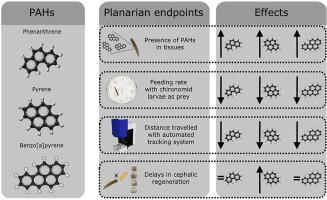Environmental Pollution ( IF 8.9 ) Pub Date : 2020-07-09 , DOI: 10.1016/j.envpol.2020.115185 Fátima C P Simão 1 , Carlos Gravato 2 , Ana Luísa Machado 1 , Amadeu M V M Soares 1 , João L T Pestana 1

|
Freshwater planarians have been gaining relevance as experimental animals for numerous research areas given their interesting features, such as high regeneration potential, shared features with the vertebrate's nervous system or the range of endpoints that can be easily evaluated in response to contaminants. Ecotoxicological research using these animals has been steadily increasing in the past decades, as planarians' potentialities for this research area are being recognized. In this work, we used polycyclic aromatic hydrocarbons (PAHs) as model contaminants and evaluated effects of exposure to phenanthrene, pyrene and benzo[a]pyrene (B[a]P) in planarians. The freshwater planarian Girardia tigrina was chosen and mortality, cephalic regeneration (during and post-exposure), behavioral endpoints and presence of PAHs in tissues, were evaluated. Mortality was only observed in planarians exposed to phenanthrene, with an estimated LC50 of 830 μg L−1. Results indicate that planarian behavioral endpoints were very sensitive in response to sub-lethal concentrations of PAHs, showing a greater sensitivity towards B[a]P and pyrene. Briefly, post-exposure locomotion and post-exposure feeding were significantly impaired by sub-lethal concentrations of all compounds, whereas regeneration of photoreceptors was only significantly delayed in planarians exposed to pyrene. Moreover, levels of PAH-type compounds in planarian tissues followed a concentration-dependent increase, showing uptake of compounds from experimental solutions. The present results highlight the importance of studying alternative and complementary endpoints, such as behavior, not only because these may be able to detect effects at lower levels of contamination, but also due to their ecological relevance. The simplicity of evaluating a wide range of responses to contaminants further demonstrates the utility of freshwater planarians for ecotoxicological research.
中文翻译:

不同的多环芳烃(PAHs)对淡水浮游生物Girardia tigrina的毒性。
淡水浮游动物已经成为许多研究领域的实验动物,因为它们具有有趣的特征,例如高再生潜力,与脊椎动物神经系统具有共同特征或可以轻松评估污染物的端点范围等,因此在许多研究领域都具有重要意义。在过去的几十年中,随着平面动物在该研究领域的潜力得到认可,使用这些动物进行的生态毒理学研究一直在稳步增长。在这项工作中,我们使用多环芳烃(PAHs)作为模型污染物,并评估了在涡虫中暴露于菲,pyr和苯并[a] re(B [a] P)的影响。淡水浮游动物Girardia tigrina选择死亡率,评估头颅再生(在暴露期间和暴露后),行为终点和组织中多环芳烃的存在。仅在暴露于菲的涡虫中观察到死亡率,估计LC 50为830μgL -1。结果表明,对亚致死浓度的PAHs响应,涡虫行为终点非常敏感,对B [a] P和pyr的敏感性更高。简而言之,所有化合物的致死浓度均显着降低了暴露后的运动和暴露后的进食,而在暴露于planar的涡虫中,光感受器的再生仅显着延迟。此外,在平面动物组织中,PAH型化合物的含量随浓度的增加而增加,表明从实验溶液中吸收了化合物。本研究结果强调了研究替代和互补终点(例如行为)的重要性,这不仅是因为这些终点能够检测出较低污染水平的影响,而且还因为它们具有生态意义。



























 京公网安备 11010802027423号
京公网安备 11010802027423号